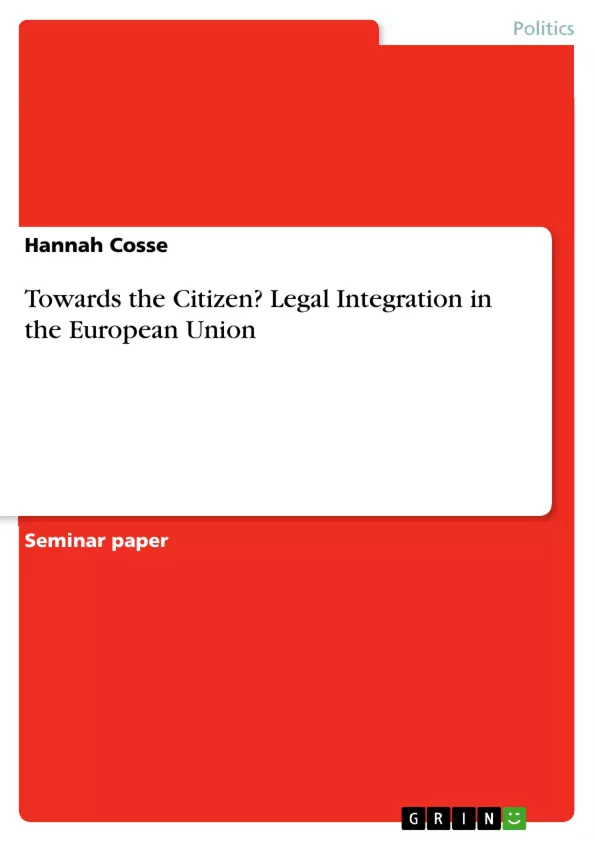The integration process of the European Union has transformed the economical cooperation of the European Coal and Steel Community (ECSC) into a somehow political entity. Starting with the ECSC in 1951, the Single European Market (SEM) was completed by the introduction of the common currency´in 2002. However, besides an economic integration, also political integration made progress – especially since the establishment of the European Union by the Maastricht Treaty (TEU) in 1992. Both different perspectives of integration were accompanied by a concise legal integration. The competences of community law have exceeded tremendously. The future of the integration process is unknown and non-predictable. However a trade-off between deepening integration and widening enlargement is the future challenge of the EU.
It is commonly agreed that ongoing integration needs a higher “connectedness” of the European Union and the Europeans. Since the 1980s the debate about how to include the Europeans a bit more in the integration process gained influence. In the 1980s the first steps were made by setting up a social charter that was mainly concerned with the rights of workers. Also the creation of the status of citizenship by the TEU in 1992 was intended to support the common market. Additionally the European Community gained new and broadened its competences in social policies. Both areas – citizenship and social policies - are directly related to the Europeans.
The concept of citizenship and also the reach of European Social Policies are arguable from a variety of starting points. Questions about identity and welfare states in general might occur. A different perspective is the legal one. Of course the effectiveness of politics cannot only be measured by the amount of law produced, but without legal consequences policy outcomes or outputs are kind of worthless. So, the core of this paper shall elaborate not on political dimensions connected to the Europeans, but on legal ones. At a first sight the formal introduction of citizenship and the inclusion of social policies in the EC Treaty might look impressive, but what they actually mean will be analysed in this paper. Especially if they might be able to connect the EU a little bit more to its citizens.
Inhaltsverzeichnis (Table of Contents)
- I. Introduction
- I.1. Preliminary References - a placement of relevance
- I.2. Methodology - the Questions
- II. European Citizenship
- II.1. Introduction to Citizenship
- II.2. Rights for Everyone?
- II.3. New rights?
- II.4. Sub-Conclusion
- III.European Social Policies
- III.1. Introduction to Social Policies
- III.2. The Development of EU Social Policy
- III.3. Driving Forces for Integration
- III.4. EU Social Policy Legislation
- III.5. Sub-Conclusion
- IV. Conclusion
Zielsetzung und Themenschwerpunkte (Objectives and Key Themes)
This paper analyzes the legal integration of the European Union since the Treaties of Maastricht and Amsterdam, specifically examining whether this integration has brought the Union closer to its citizens. The paper focuses on two key areas: European Citizenship and European Social Policies. The objective is to assess the effectiveness of these legal instruments in connecting the EU with its citizens.
- The impact of legal integration on the relationship between the EU and its citizens.
- The role of European Citizenship in granting new rights to Europeans.
- The evolution of European Social Policies and their driving forces.
- The extent of EU competences in social policies.
- The symbolic and practical effects of legal integration on the lives of Europeans.
Zusammenfassung der Kapitel (Chapter Summaries)
The introduction provides a historical overview of the European integration process, highlighting the shift from economic cooperation to political integration. It outlines the key milestones, including the establishment of the ECSC, the completion of the SEM, and the creation of the European Union through the Maastricht Treaty. The introduction also introduces the paper's research question: did legal integration since the Treaties of Maastricht and Amsterdam bring the Union closer to its citizens?
The chapter on European Citizenship explores the concept of citizenship as introduced by the TEU in 1992. It examines the rights granted to Europeans under the Treaty and delves into the questions of who is entitled to citizenship and the content of those rights. The chapter also discusses the role of the European Union in social policies, tracing its development and identifying the driving forces behind this evolution. The chapter analyzes the competences of the EU in social policies, providing an overview of its legislative framework.
Schlüsselwörter (Keywords)
Key terms and concepts central to the paper include: European integration, legal integration, European Citizenship, social policies, EU competences, Treaty of Maastricht, Treaty of Amsterdam, symbolic effects, practical effects, and the relationship between the EU and its citizens.
- Citation du texte
- Hannah Cosse (Auteur), 2006, Towards the Citizen? Legal Integration in the European Union, Munich, GRIN Verlag, https://www.grin.com/document/70289



